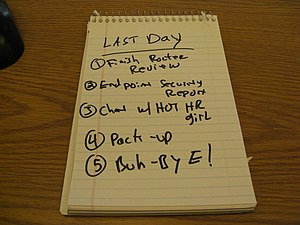 I did complete all of those tasks?(Photo credit: Wikipedia)
I did complete all of those tasks?(Photo credit: Wikipedia)Time Management – Becoming Better Organized
My three earlier posts about Time Management;
- The Clock Is Ticking! How Good Are You At Time Management), (
- Time Management: Know Where Time Goes - Keep A Log
- Pinpointing Those Emotional Blocks to Change,
said that the first three steps in managing time are
- To be clear about your purpose and your direction in life,
- To know how you spend your time
- To include an emotional element in your time management program.
Now you need to be become better organized.
The easiest way to do this is by using a written “To Do” list. You can do this on line or in a simple note book.
Each task needs to be prioritized and given a deadline. For example,
- Priority 1 Top Priority – By the end of the week,
- Priority 2 Medium Priority - By the end of the month
- Priority 3 Low Priority – No Deadline.
You will notice that High Priority tasks usually reflect the 80/20 rule – the biggest results often come from the smallest percentage of activities.
If you look at your time log, you will see that a lot of your time is consumed by activities that don't actually appear on your To Do list, for example chatting to your friends on the phone. Good time management isn't about not chatting to friends but it is about recognizing your real priorities.
Get top priority tasks you don't enjoy out of the way first and reward yourself by then doing something you enjoy.
If you have too many top priority tasks sit down and think about them again – consider seriously what really can wait.
Always aim to completely finish one task before moving on to another. If you can't complete the whole of one task, complete a measurable part of it. That way you will feel in control and you will achieve something.
It helps to break large tasks down to their constituent parts and assign a time period for completing each one – it is better to over- rather than under-estimate the time a part will take. Balance the time you take on something against what you achieve. If it is taking too long try to work out why and look at another way of doing it.
Make sure your To Do list is tied into to your personal long term goals. You can use a wall chart to show this and it will help to keep you motivated.
If there are tasks you can delegate or pass on to someone else, then do it if you can. Remember you are valuable and so is your time. But do take into account how long you might have to spend teaching and supervising them.
Don't use your time management program like a new toy and keep playing with it and, for instance, reorganizing your priorities. That means the list gets in the way of actually achieving something. Treat it as a simple and practical tool to help you get things done.
Take a few minutes each evening to reflect and enjoy your achievements - be kind to your self about what is undone. Review what you have achieved and plan for tomorrow. Then when tomorrow comes you are ready to get on and complete more tasks.
If you would like help learning to manage your time - get in touch. My email address is below.
Want to be a Confident Networker? Join my free teleseminar on 26thJune 2012
Wendy Mason is a Life and Career Coach. She helps people have the confidence they need to be successful at work and to change career while maintaining a good work/life balance. You can email her at wendymason @wisewolfcoaching.com






Comments
Post a Comment
I am very grateful for your comment. Thank you!